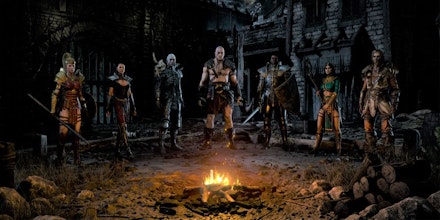When Diablo II arrived in the summer of 2000, the title, like its leaping barbarian, made a shuddering impact on the gaming landscape. Setting the bar for action RPGs (one many would argue has yet to be cleared), Blizzard's grimdark tale of angels, demons, copious loot, and endless slaughtered quill rats was swiftly elevated to the rank of gaming royalty, and not without good reason. This year’s Diablo II: Resurrected, however, is a game that straddles two worlds (besides those of Hell and Sanctuary). On the one hand it is an unerringly faithful recreation of one of the best video games of all time. On the other, though, it is a title very much mired in the year 2000 and subject to all the quirks and frustrations that go with it.

First the good, though. From the moment we first hear the tale of the Dark Wanderer recounted (in a beautifully updated and re-rendered cutscene), it’s instantly obvious how Diablo’s sequel carved its name into the pantheon of all time greats. Over the course of the game’s five distinct acts (Resurrection includes the 2001 Lord of Destruction expansion), its fiendishly addictive blend of fast-paced carnage and compulsive loot-hunting carries you from the Tristram fields, through deserts, jungle, and finally the infernal depths of Hell itself for the confrontation with Diablo himself.
A product of its era, Diablo II comes replete with a number of features that jar when set against modern titles.
Taking a distinctly different flavour depending on which of the game’s seven classes you choose from (barbarian, sorceress, assassin, druid, necromancer, amazon, or paladin), the gameplay is both instantly accessible, yet fathomless in depth, rewarding those who take the time to study their class and carefully choose builds to compliment their preferred playstyle. High level play — especially for those venturing into Nightmare or Hell difficulty — necessitates a degree of gear farming that may or may not be to your tastes and will have you cursing the RNG gods regardless, but given how enjoyable the game’s wholesale slaughter tends to be, it’s rarely too gruelling a task.
Designed for PC, the controls have been intuitively translated to the controller, a combination of face buttons and trigger modifiers standing in for numbered hotkeys as you frantically deploy combat skills or quaff endless potions. Some abilities are trickier to target with precision using the D-Stick, and inventory management (more on that later) is more cumbersome but other than that, the gameplay survives its move to consoles intact.
Visually, the game is a million miles away from its VGA beginnings, retaining every aspect of the game’s dour and foreboding aesthetic but giving it a stunning 4K facelift and replacing janky sprites with proper 3D modelling. Those wishing to see just how far the graphics have come, can switch from the Resurrected look to the blocky original at will — though we can’t recommend it for more than an occasional glance for curiosity’s sake. Everything from the look and feel of the Rogue Encampment to the sand-blasted walls of Lut Gholein have been reconstructed with slavish fidelity; even the game’s interface is presented largely unchanged.

Such devotion to the original comes at a heavy cost, however. A product of its era, Diablo II came replete with a number of features that jar when set against modern titles. Lacking the UI polish of ‘inferior’ sequel Diablo III, II, while a delight in some areas, is a cumbersome beast in others. Devoid of anything resembling a tutorial (Diablo II existed in an age when games still came with manuals to be pored over), the game largely leaves you to figure things out on your own, never alerting you, for example, to the fact that you can increase your stats as you level, in addition to load points into abilities from the various skill trees.
Meanwhile, NPCs deliver whopping great blocks of expository text with no input from the player in the way that RPGs have since moved away from. Diablo was never as verbose as the likes of Baldur’s Gate or Planescape: Torment, but the frequent monologues do feel, as they are, plucked from a bygone era. More arduous by far, however, is the endless, tedious inventory management. For a game obsessed with loot, your character can hold precious little of it, requiring a portal back to town several times each mission just to offload the junk that pops from dying foes. Mildly annoying in 2000, it’s absolutely maddeningly in 2021, when streamlined gameplay and simple quality of life improvements like being able to offload to your stash remotely (thank you updated Demon’s Souls) are now taken for granted. Where Diablo III at least did away with the need to make room for every minor potion, here we’re back to shuffling through our bags every two minutes, re-jigging bottles and elixirs like an overly finicky pharmacist just to make room for another Unidentified Cracked Cap that just dropped from a Fallen Shaman.
Diablo II: Resurrected, then, is something of a mixed blessing. On the one hand, this is a ground-up rebuild that faithfully recreates one of the greatest games of all time. For those old enough to have trodden the paths of Tristram and taken down Diablo with their mouse and keyboard back in the noughties, this is a perfect recreation of that epic struggle, one that has lost none of its impact and now harnesses all the power of modern hardware. For those new to Diablo’s world, however, Resurrection will feel uncomfortably like what it is: a relic from a bygone era. Make no mistake, this is a milestone in gaming and a classic in every sense, but it’s one that requires a level of patience modern gamers might not be as willing to suffer through.
